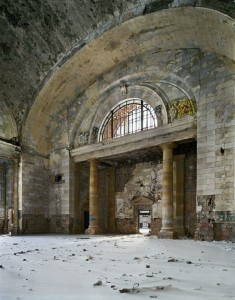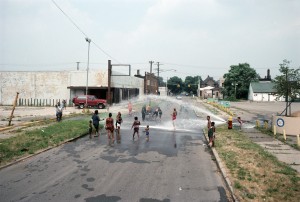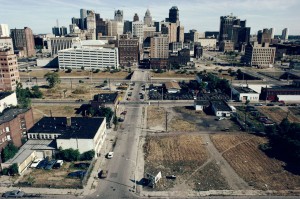
Inside the station. “Waiting room with snowdrift, Michigan Central Station” by Andrew Moore (click to enlarge)
Michigan Central Station is a carcass of a building, looming over Detroit’s west side. Once an emblem of inflatable obstacle course Detroit’s prosperity, the towering structure is now an emblem of its desperation. Its 18 stories of windows are smashed-in, leaving jagged glass teeth in their panes. Its front façade—towering windows framed by elegant pillared arches—are just as battered, ravaged by the hurricane that never was. The neoclassical flourishes that once suggested elegance now evoke malevolence, like the macabre ornamentation of a supervillain’s lair.
In separate exhibits at the National Building Museum in Chinatown, two photographers tell the story of the station and the story of a city. The ruins Inflatable Jumpers of Detroit are the subject of both “Detroit Disassembled” by Andrew Moore and “Detroit is No Dry Bones” by Camilo José Vergara. Far more than just the decline of the Motor City, the images offer a glimpse at the dregs of bygone American industrial might.
Moore has presented the decline in more dramatic fashion, and I recommend visiting his exhibit first. His images are “printed on the scale of epic history paintings, belonging to an artistic tradition that began in the 17thcentury,” and they capture what remains of the shuttered factories and skyscrapers that inflatable tent for sale defined Detroit in its industrial heyday. The squalor in the photos is overwhelming: blight, graffiti, debris, squatters’ camps, mature trees breaking through concrete.
If you’re not familiar with Detroit, you might have a hard time believing wreckage of such monumental scale truly exists, right here in the United States. Moore compares it to Pompeii, and he’s right. Not only does Detroit resemble a disaster zone, it appears as if one tobogan inflable day everything just stopped. Amid the rubble, portraits still hang on walls, test tubes and notebooks fill empty classrooms, and case files lie open in vacated police stations.
While looking at shot after shot of such vulgar post-industrial carnage, I started to feel that Moore’s instincts might be more gluttonous than documentary. At what point does his focus on only the most extreme examples of ruination become a misrepresentation, a disservice to citizens of Detroit and museum patrons in DC? After all, there are still 700,000 people living in the city, and hardly a one makes it into Moore’s photos.
Detroiters do show their faces and some of their spirit in Camilo José Vergara’s exhibit. Like Moore, sociologist-with-a-camera Vergara admits to being awestruck by Detroit’s ruins. But he seems a bit more capable than his counterpart of reflecting upon that awe, capturing crumbling houses and storefronts in humbly sized prints.
Vergara gives a nod to “the Detroiters who never left,” and the pictures of their endurance are his most arresting: the deadpan stares of a family outside a storefront church; the light rail “People Mover” making its way through an empty, wintry downtown; the small business owner perched outside his renovated restaurant. Wrecked buildings are Vergara’s most frequent subject, though. By photographing the same street corners yearly for decades, he shows us Detroit’s evolution: the buildings that have been gradually vanquished by nature, and also a few that have been rescued from the brink and rebuilt.
But for all the focus on houses, storefronts, and factories, both artists seem to have forgotten that Detroit’s true ruination is human. The city perennially ranks as one of America’s most violent, a third of its residents live in poverty, and the city government struggles to provide services as basic as trash collection. According to Jerry Herron, half of the city’s residents say they would leave if they could.
This is the human aching that is woven through the aching buildings captured by Moore and Vergara; I wish they had made more than a token effort to point it out. Such intense physical decay doesn’t occur in a vacuum: Detroit’s buildings and residents were both ravaged by the same deindustrialization process.
Both photographers profess an interest in Detroit’s ruins as windows into a bygone era. While you view their photos, it’s worth reflecting for a moment on what exactly made that era so noteworthy. Fifty years ago, Detroit was the center of a different America, one in which a union job in an auto factory provided enough money for a home, a car, and a picket fence. In his book The Conscience of A Liberal, Paul Krugman calls it a “Middle-Class Nation.”
That’s why the decay captured in these photographs has such brutal symbolism. As factories moved overseas and union power waned, these jobs weren’t replaced. Today, two-thirds of Americans work in a service economy with sparse benefits, little job security, and an average wage barely above $30,000.
One of Andrew Moore’s most poignant photos is of Ford’s River Rouge plant. This was the company’s flagship factory, employing 120,000 workers in the 1940s, today just 6,000. The walls of the long, rectangular room are curiously painted blue, green, and orange. In the foreground are a few giant, disintegrating wooden spools. It’s a mess. Good thing both buildings and economies can be repaired. Moore and Vergara have given us a chance to think about both, and it’s one not to be missed.
“Detroit Disassembled” and “Detroit Is No Dry Bones” are showing at the National Building Museum until February 18th, 2013. All photos courtesy of the museum. Chris Lewis is a DC resident and Michigan native. Follow him on Twitter @chris_lewis_.



